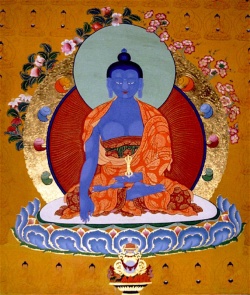Akshobhya
In Vajrayana Buddhism, Akshobhya (Sanskrit: अक्षोभ्य, Akṣobhya, "Immovable One"; simplified Chinese: 阿閦如来; pinyin: Āchùrúlái; Japanese:阿閦如来) is one of the Five Wisdom Buddhas, a product of the Adibuddha, who represents Consciousness as an aspect of reality. By convention he is located in the east of the Diamond Realm and is the Lord of the Eastern Pure land Abhirati ('The Joyous'), although the Pure land of Akshobhya's western counterpart Amitābha is far better known. His consort is Lochanā and he is normally accompanied by two Elephants. His color is blue and his attributes include the Bell, three robes, and staff, along with a jewel, Lotus, prayer Wheel, and sword. He has several emanations.
Akshobhya
阿k仏 (Skt; Jpn Ashuku-butsu)
A Buddha said to be lord of the Land of Joy (Skt Abhirati) located in the east. Akshobhya means immovable; hence this Buddha is also known by the name Immovable. According to the Land of Akshobhya Buddha Sutra, Akshobhya Buddha carried out his bodhisattva practice under the Buddha Large Eyes and attained enlightenment, completely freeing himself from all animosity and earthly desires, and now preaches in the Land of Joy. According to the "Parable of the Phantom City" (seventh) chapter of the Lotus Sutra, Wisdom Accumulated, the first of the sixteen sons of Great Universal Wisdom Excellence Buddha, following his father, practiced the Lotus Sutra and attained enlightenment as Akshobhya Buddha. The Nirvana Sutra describes King Possessor of Virtue and the monk Realization of Virtue as having been born together in the land of Akshobhya Buddha. Akshobhya Buddha, who is said to dwell in the east, appears in many Mahayana sutras along with Amida Buddha of the west.
Akshobhya (S): Tibetan: Mi-kyö-pa. "Unshakeable One." Lord of the Vajra Family, one of the Five Dhyani Buddhas, or heads of the Five Buddha Families, representing the fully purified Skandha, or Aggregates of Form. In the Natural Liberation, he represents the Wisdom-mirror and the transmutation of the poison of aggression and hatred. Akshobhya is blue, and is associated with the east and the ground - Abhirati Buddha. He originates from the blue seed syllable HUM and represents the Vajra family; immutable and imperturbable. The Path to Enlightenment through the Vajra family is one of breaking free of constraints and obstacles, transmuting negativity, and is generally more dynamic and proactive. He makes the Earth touching Mudra (S. bhumisparsa) with the tip of the middle finger touching the Earth with palm drawn inwardly, while his left hand rests on his lap face . He faces the East and, is often depicted with his consort Lochana, She of the Buddha eye, who expresses the mirror-like primordial Wisdom.
==Origin==
Akshobhya appears in the "Scripture of The Buddha-land of Akshobhya" (Chinese: 阿閦佛國経; pinyin: Āchùfó Guó Jīng), which dates from 147 AD and is the oldest known Pure land text. According to the scripture, a Monk wished to practice the Dharma in the eastern World of delight and made a vow to think no Anger or malice towards any being until Enlightenment. He duly proved "immovable" and when he succeeded, he became The Buddha Akshobhya.
Akshobhya is sometimes merged with Acala (jap. 不動明王 Fudō-myōō?), whose name also means 'immovable one' in Sanskrit. However, Acala is not a Buddha, but one of the [[Five Wisdom Kings of the Womb Realm in Vajrayana.
Prior to the advent of Bhaisajyaguru (jap. Yakushi Nyorai), Akshobhya was the subject of a minor cult in Japan as a Healing Buddha, though even now both are found within the Shingon school of Buddhism in Japan.
Recently, newly discovered Gāndhārī texts from Pakistan in the Bajaur Collection have been found to contain fragments of an early Mahāyāna Sutra mentioning Akshobhya. Preliminary dating through palaeography suggests a late 1st century to early 2nd century AD provenance. More conclusive radiocarbon dating is under way. A preliminary report on these texts has been issued by Dr Ingo Strauch, with a forthcoming paper on Akshobhya texts expected soon.
==Iconography==
Akshobhya is the embodiment of 'mirror Knowledge' (Sanskrit: ādarśa-jñāna; refer Panchajnana). A Knowledge of what is real, and what is Illusion, or a mere reflection of actual reality. The mirror is Mind itself - clear like the sky, empty yet luminous. Holding all the images of space and time, yet untouched by them. He represents the eternal Mind, and the Vajra family is connected with reason and intellect. Its brilliance illuminates the darkness of Ignorance, its sharpness cuts through confusion.
The Vajra family, to which Akshobhya belongs, is associated with the element of water. This is why the two colours of Vajra are blue or white. Bright white like sun reflecting off water, and blue, like the depths of the ocean. Even if the surface of the ocean is blown into crashing waves, the depths remain undisturbed, imperturbable. And though water may seem ethereal and weightless, in Truth it is extremely heavy. Water flows into the lowest place and settles there. It carves through solid rock, but calmly, without violence. When frozen, it is hard, sharp, and clear like the intellect, but to reach its full potential, it must also be fluid and adaptable like a flowing river. These are all the essential qualities of Akshobhya.
Many wrathful tantric beings are represented as blue in colour because they embody the transmuted energy of hatred and aggression, into Wisdom and Enlightenment.

